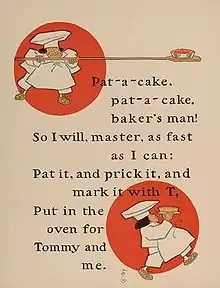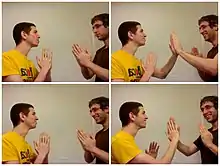Pat-a-cake, pat-a-cake, baker's man
"Pat-a-cake, pat-a-cake, baker's man", "Pat-a-Cake", "Patty-cake" or "Pattycake" is an English nursery rhyme. It has a Roud Folk Song Index number of 6486.[1]
| "Pat-a-cake, pat-a-cake, baker's man" | |
|---|---|
 William Wallace Denslow's illustrations for Pat-a-cake, pat-a-cake, baker's man, from a 1901 edition of Mother Goose | |
| Nursery rhyme | |
| Published | 1698 |
| Songwriter(s) | Traditional |
Verse
- Pat-a-cake, pat-a-cake, baker's man.
- Bake me a cake as fast as you can
- Roll it, pat it, and mark it with a B
- Put it in the oven for Baby and me.[2]
Origins
The earliest recorded version of the rhyme appears in Thomas D'Urfey's play The Campaigners from 1698, where a nurse says to her charges:
...and pat a cake Bakers man, so I will master as I can, and prick it, and prick it, and prick it, and prick it, and prick it, and throw't into the Oven.[2]
The next appearance is in Mother Goose's Melody (c. 1765) in the form:
- Patty Cake, Patty Cake,
- Baker's Man;
- That I will Master,
- As fast as I can;
- Pat it and prick it,
- And mark it with a T,
- And there will be enough for Tommy and me.
Marking pastry or baked goods with an identifiable mark may stem from a time when households without an oven of their own could take their items to a local baker or bake house, paying to have their items finished for a small fee. Marking the pastry would have been a way to ensure the return of the proper item.[3]
The earliest version set to music appears in James Hook's "A Christmas Box" (1796).[4]
Game

The rhyme often accompanies a clapping game between two people. It alternates between a normal individual clap by one person with two-handed claps with the other person. The hands may be crossed as well. This allows for a possibly complex sequence of clapping that must be coordinated between the two. If told by a parent to a child, the "B" and "baby" in the last two lines are sometimes replaced by the child's first initial and first name.[2]
The "pat-a-cake" song and clapping game was used by Bob Hope and Bing Crosby in their series of "Road to" films. The gag worked by means of adding a synchronised punch into the clapping game routine, allowing them to make their escape.[5]
See also
References
- "Roud Folksong Index S218300 Pat-a-cake, pat-a-cake, baker's man". Vaughan Williams Memorial Library. English Folk Dance and Song Society. Retrieved 20 May 2016.
- I. Opie and P. Opie, The Oxford Dictionary of Nursery Rhymes (Oxford University Press, 1951, 2nd edn., 1997), pp. 341–2. ISBN 9780198600886.
- Horrible Histories:Gorgeous Georgians
- Christmas Box by Mr Hook (p.13)
- The "Road..." Films of Hope, Crosby and Lamour